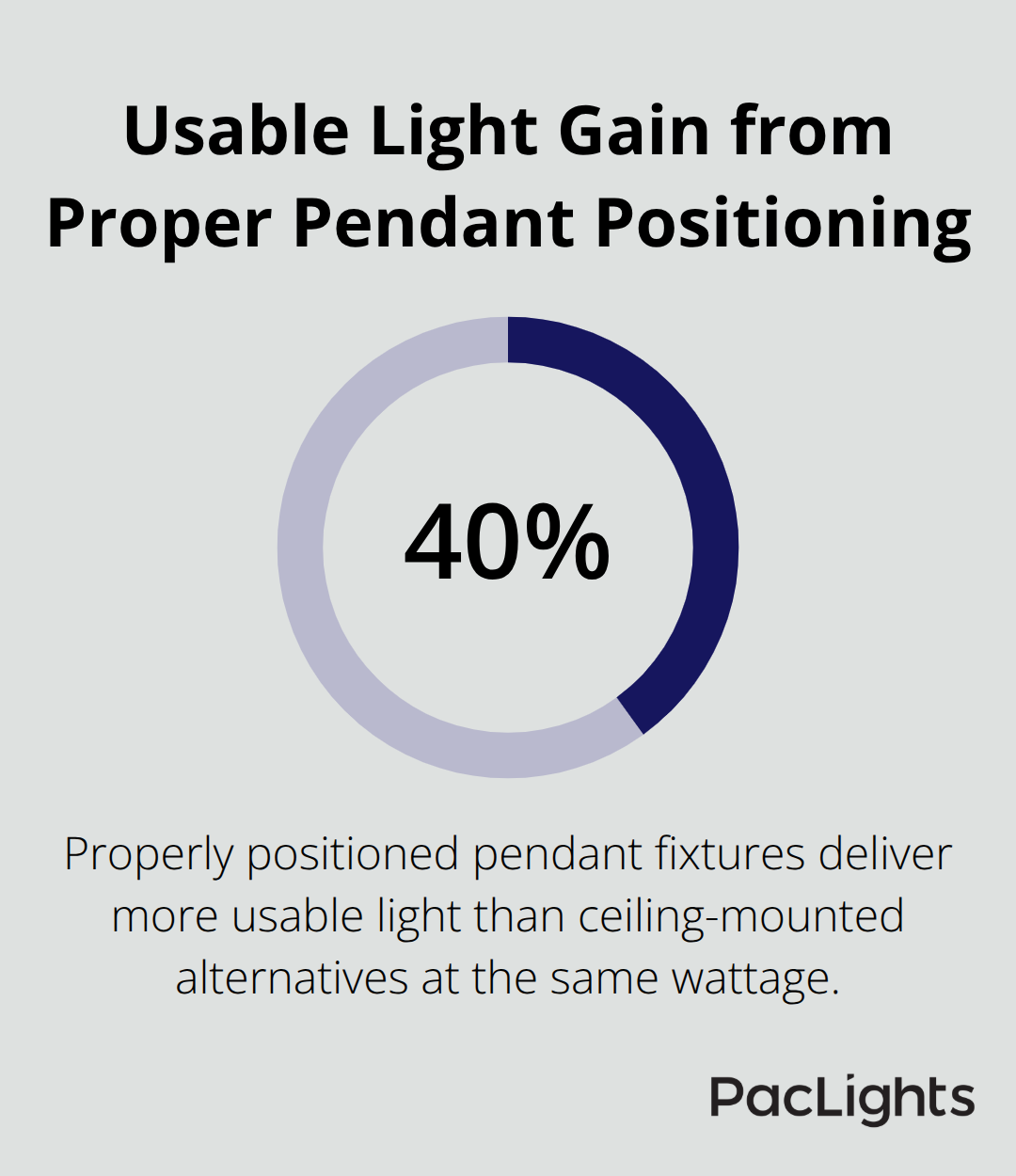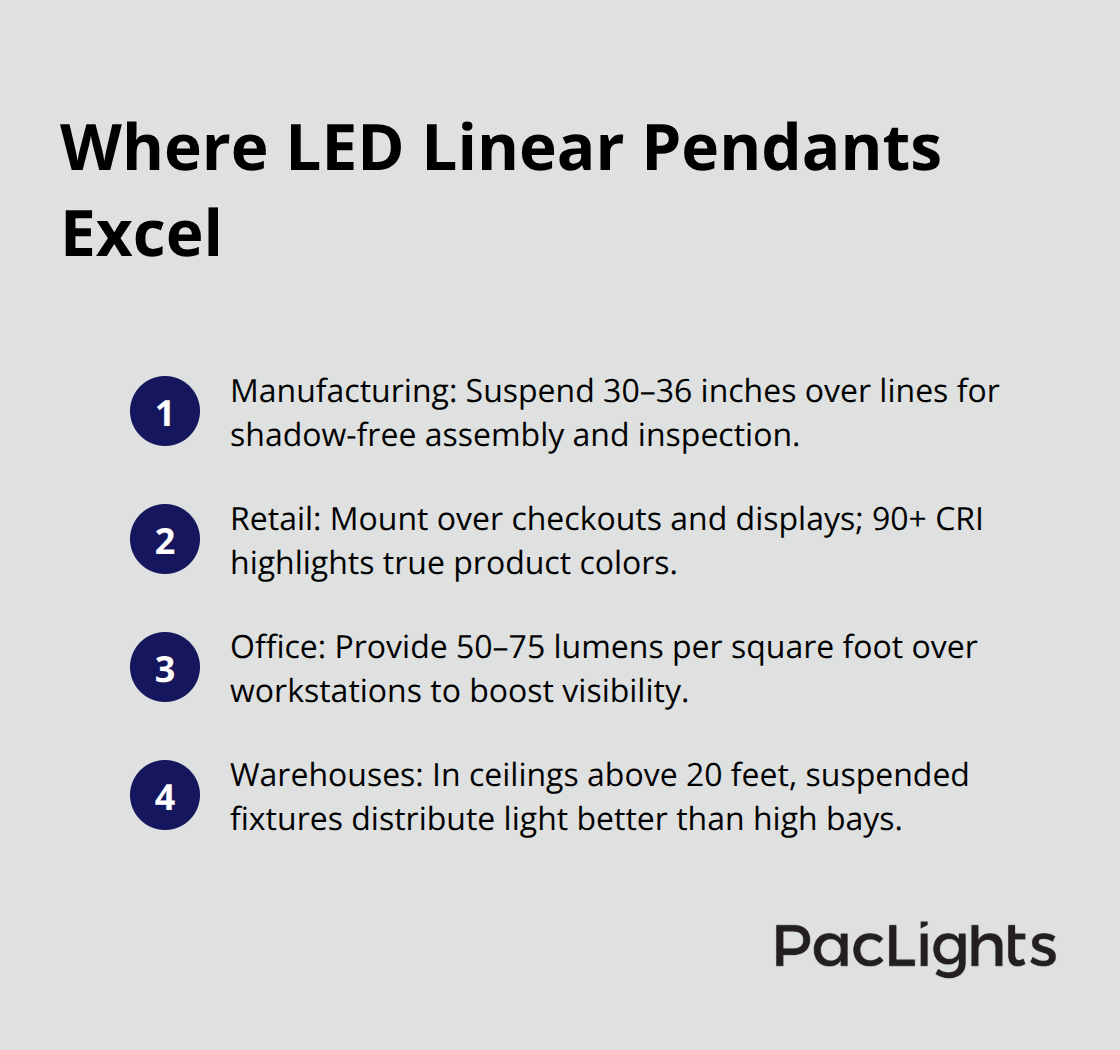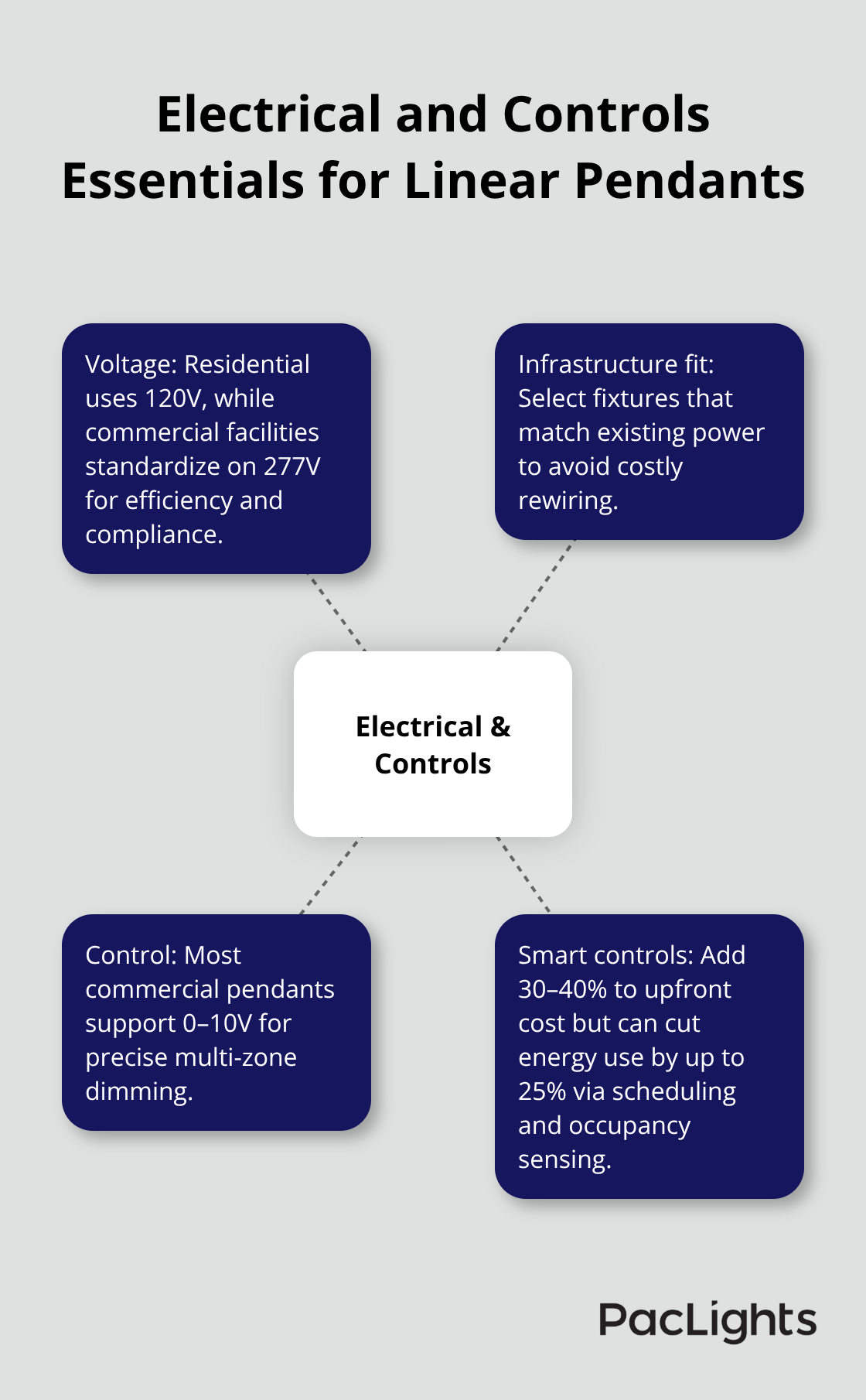LED linear pendant light fixtures have become the go-to solution for modern commercial and industrial lighting projects. These versatile fixtures deliver superior energy efficiency while providing excellent illumination across large spaces.
At PacLights, we see businesses struggling with outdated lighting systems that drain energy budgets and fail to meet current performance standards. The right LED linear pendant selection can cut energy costs by up to 75% compared to traditional fluorescent systems.
What Makes LED Linear Pendant Lights Different
LED linear pendant lights represent a fundamental shift from traditional fluorescent strip lights in both design and performance. These fixtures suspend from the ceiling with cables, chains, or rigid stems, which positions the light source closer to work surfaces for improved illumination efficiency. The National Electrical Manufacturers Association reports that properly positioned pendant fixtures deliver 40% more usable light compared to ceiling-mounted alternatives at the same wattage. Linear pendants typically measure between 24 and 96 inches in length, with aluminum housings that dissipate heat effectively while maintaining consistent light output over their 50,000-hour lifespan.

Core Components That Matter
The LED driver serves as the fixture’s brain and converts AC power to the precise DC voltage LEDs require. Quality drivers from manufacturers like Mean Well or Philips include dimming capabilities and surge protection, which extends fixture life significantly. The optical system includes either prismatic lenses for wide distribution or parabolic reflectors for focused task lighting. Fixtures rated for commercial use feature 0-10V dimming compatibility and operate at 277V for energy efficiency. Weight considerations matter too – most linear pendants weigh 8-25 pounds and require ceiling boxes rated for at least 50 pounds according to electrical codes.
Where Linear Pendants Excel
Manufacturing facilities benefit most from linear pendants over assembly lines and inspection stations, where the 30-36 inch suspension height provides shadow-free illumination. Retail environments use these fixtures over checkout counters and merchandise displays and take advantage of their high color rendering index of 90+ for accurate product representation. Office environments see productivity gains when linear pendants provide 50-75 lumens per square foot over workstations (compared to the 20-30 lumens sufficient for general ambient lighting). Warehouses with ceiling heights above 20 feet achieve better light distribution with suspended fixtures than with high bay alternatives.

Performance Advantages Over Traditional Options
LED linear pendants consume 75% less energy than fluorescent equivalents while they last 15-20 years compared to 2-3 years for traditional bulbs. A 60-inch LED linear pendant typically produces 3,000-4,500 lumens and efficiently lights areas of 150-200 square feet. These fixtures generate minimal heat unlike incandescent bulbs, which reduces fire hazards and cooling costs in commercial spaces. The modular design allows adjustments in layout as needs change, though connection points can lead to variations in light output that require careful planning.
With these performance characteristics established, the next step involves evaluating specific technical requirements that will determine which fixtures best match your project needs.
What Specifications Really Matter for Your Project
Lumens output determination starts with space requirements rather than generic recommendations. Manufacturing facilities need 50-100 lumens per square foot for assembly work, while warehouses require only 20-30 lumens for general movement. The Illuminating Engineering Society specifies that inspection stations demand 100-200 lumens per square foot for quality control tasks. A 60-inch LED linear pendant that produces 4,500 lumens covers approximately 150 square feet at standard levels, but only 75 square feet for detailed inspection work. Calculate total lumens needed first, then select fixtures that match rather than oversize and waste energy costs.
Installation Height Affects Performance
Pendant height directly impacts light distribution patterns and energy efficiency. The 30-36 inch standard works for most applications, but task-specific heights deliver better results. Assembly lines perform best with pendants that hang 24-30 inches above work surfaces to minimize shadows from workers’ hands. Retail displays need 36-48 inches to prevent customer head strikes while they maintain product visibility. Spaces with 12-foot ceilings require reinforced systems for pendants over 15 pounds, while 20-foot warehouse ceilings benefit from adjustable cable systems that accommodate seasonal inventory changes.
Color Temperature Drives Worker Performance
Color temperature selection impacts worker performance more than most facility managers realize. Workers show 15% productivity increases with 4000K-5000K that mimics natural daylight and reduces eye strain. Retail spaces need 3000K for clothing and fabric displays to show accurate colors, while electronics require 5000K for component identification. Food processing facilities must use 4000K minimum to meet FDA inspection standards. Color Rendering Index above 90 costs 20-30% more but pays for itself through reduced error rates in quality control applications (avoid 2700K warm light in industrial settings as it reduces alertness and increases safety incidents according to OSHA studies).
Voltage Requirements and Electrical Considerations
Standard residential installations use 120V electrical systems, while commercial applications require 277V for efficiency and compliance. Fixtures must match your facility’s electrical infrastructure to avoid costly rewiring projects. Most commercial linear pendants operate on 0-10V systems that allow precise control over multiple zones. Smart controls add 30-40% to initial costs but reduce energy consumption by up to 25% through automated schedules and occupancy sensors.

These technical specifications form the foundation for smart fixture selection, but energy efficiency calculations will determine your project’s long-term financial success.
Real Energy Savings from LED Linear Pendants
LED linear pendant fixtures deliver measurable energy reductions that transform facility costs within 18-24 months. A typical 400-watt metal halide fixture consumes 455 watts (including ballast losses), while an equivalent LED linear pendant uses just 120 watts for the same light output. This 73% reduction translates to $2,010 annual savings per fixture at commercial electricity rates of $0.12 per kWh based on 4,000 hours of operation. The Department of Energy confirms LED fixtures maintain 90% lumen output after 50,000 hours compared to fluorescent systems that drop to 70% after just 10,000 hours.
Payback Calculations with Real Numbers
Calculate your return on investment with actual facility data rather than manufacturer estimates. A 100-fixture warehouse upgrade from fluorescent to LED linear pendants costs $45,000 installed but saves $18,500 annually in energy costs alone. Add $8,200 yearly maintenance savings from the 50,000-hour LED lifespan versus 8,000-hour fluorescent tubes, and your total annual benefit reaches $26,700. This delivers a 1.7-year payback period before utility rebates.
Most utility companies offer $25-75 per fixture rebates for LED upgrades, which reduces your initial investment by 15-25%. The North American Energy Standards Board reports commercial facilities see 3-year average paybacks on LED conversions, but linear pendant projects typically beat this timeline due to their high-use applications and superior efficiency gains.
Utility Rebate Programs Worth Pursuing
Apply for utility rebates before installation begins since most programs require pre-approval and specific fixture certifications. California utilities offer up to $150 per fixture for DLC-listed LED linear pendants in manufacturing facilities. Texas programs provide 50% cost reimbursement up to $10,000 per project for energy-efficient upgrades.
Federal tax credits cover 30% of commercial LED installation costs through 2025, but only for fixtures that meet Energy Star requirements. Combine multiple incentive programs to reduce net project costs by 40-60% in many regions.
Long-term Maintenance Cost Reductions
LED linear pendants eliminate the frequent bulb replacements that plague fluorescent systems. Traditional fluorescent tubes require replacement every 8,000-12,000 hours, while LED fixtures operate for 50,000+ hours without degradation. This difference saves facilities $15-25 per fixture annually in labor costs alone. Factor in reduced disposal fees for hazardous fluorescent materials, and maintenance savings often exceed energy savings in the first five years of operation.
Final Thoughts
LED linear pendant light fixtures transform facility operations through precise technical specifications that match work requirements. Manufacturing facilities achieve optimal results with 50-100 lumens per square foot, while warehouses operate efficiently at 20-30 lumens. Color temperatures between 4000K-5000K boost worker productivity by 15% compared to traditional systems.
These fixtures deliver 73% energy reductions and achieve 1.7-year payback periods in typical commercial applications. The 50,000-hour lifespan eliminates maintenance cycles that burden fluorescent systems. Utility rebates of $25-75 per fixture and federal tax credits (covering 30% of installation costs) accelerate return on investment.
Calculate your actual energy consumption and identify available rebate programs before you begin your upgrade project. We at PacLights provide lighting layout designs and ROI assessments for your facility’s specific needs. Professional guidance helps you avoid costly mistakes and maximize long-term savings.


Disclaimer: PacLights is not responsible for any actions taken based on the suggestions and information provided in this article, and readers should consult local building and electrical codes for proper guidance.